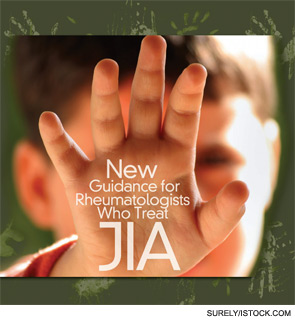
Recent advances in the treatment of juvenile idiopathic arthritis (JIA) have dramatically improved outcomes for children with these conditions. To provide an evidence base for treatment for JIA, an analysis of these advances has been presented in the recently published “2011 ACR recommendations for the treatment of juvenile arthritis.” These recommendations represent the development, for the first time, of validated guidance regarding the safest and most effective treatment of this chronic childhood disease.1 The recommendations are based on a systematic review of the literature and a formal group assessment process conducted by a core expert panel and task force panel composed of pediatric rheumatology clinicians and researchers from the United States, Canada, and Europe.
“Treatment of JIA has undergone major changes, first with the widespread use of methotrexate and then with the introduction of biologic agents,” says Timothy Beukelman, MD, MSCE, principal investigator and co-author of the recommendations. “The ACR recommendations are the first major attempt to provide detailed evidence and consensus-based guidance regarding the initiation and monitoring of therapeutic agents in the treatment of JIA.”
Therapeutic agents included in the recommendations are nonsteroidal antiinflammatory drugs (NSAIDs), intraarticular glucocorticoid injections, nonbiologic disease modifying antirheumatic drugs (DMARDs), biologic DMARDs, and systemic glucocorticoids for treatment of systemic features of systemic arthritis.
Economic analyses and cost implications of specific therapies are not part of the recommendations, and the recommendations are not intended to be used to determine insurance coverage policies or to limit healthcare coverage, says Dr. Beukelman, assistant professor of pediatrics in the Division of Pediatric Rheumatology at the University of Alabama at Birmingham. “My personal hope is that the recommendations will result in increased access to appropriate treatment for children with arthritis,” he notes.
Because of the broad international input, the recommendations are expected to inform and benefit physicians throughout the world and to be a “useful guide to clinicians at all levels of experience with the treatment of JIA,” Dr. Beukelman says. Even though some of the recommendations do not represent current regulatory agency–approved labeling, they do reflect “common and widely accepted practices in the field.”
Treatment Groups
Five treatment groups are identified in the 2011 ACR recommendations, which differs from the most recent ILAR (International League of Associations for Rheumatology) classification criteria that names six categories. The five treatment groups are:
- Patients with a history of arthritis of four or fewer joints throughout the history of their disease course. This group can include patients with persistent oligoarthritis, psoriatic arthritis, enthesitis-related arthritis, and undifferentiated arthritis.
- Patients with a history of arthritis of five or more joints throughout the history of their disease, which can include those with extended oligoarthritis, rheumatoid factor (RF-)– negative polyarthritis, RF-positive polyarthritis, enthesitis-related arthritis, and undifferentiated arthritis.
- Patients with active sacroiliac arthritis, which includes children with clinical and imaging evidence of active sacroiliac arthritis. This group likely will include patients with enthesitis-related arthritis and psoriatic arthritis, as well as patients from any of the ILAR JIA categories.
- Patients with systemic arthritis with active systemic features (and without active arthritis). An example would be a child whose arthritis resolved spontaneously or rapidly upon initiation of NSAIDs therapy but who had persistent fever.
- Patients with systemic arthritis with active arthritis (and without active systemic features). An example would be a child whose systemic features resolved spontaneously or rapidly upon initiation of NSAIDs therapy but whose arthritis remained active.
Each treatment group has its own features of poor prognosis, and the presence of one of these features qualifies the patient as having a poor prognosis. Subsequent treatment recommendations are given, which are based on whether the patient has a low, moderate, or high disease activity level.
Online Resource
Download these and other treatment recommendations, as well as practice guidelines, online at www.rheumatology.org via the Practice Management menu.
Therapies Recommended
Guidance about the use of intraarticular glucocorticoid injections and use of methotrexate when initiating tumor necrosis factor (TNF-)–α inhibitor therapy is included in the recommendations and applies broadly across the five treatment groups.
Intraarticular glucocorticoid injections are recommended for active arthritis regardless of concurrent therapy, and this therapy should result in clinical improvement of arthritis for at least four months. If that improvement occurs, the injections may be repeated. If the clinical response is shorter than four months, an increase in systemic therapy may be needed.
When TNF-α inhibitor therapy (etanercept or adalimumab) is initiated, methotrexate should be continued for patients who have previously had a partial clinical response to methotrexate. Continuing methotrexate is appropriate when initiating infliximab because methotrexate can reduce the production of neutralizing antibodies to infliximab. That approach is also consistent with the labeling on infliximab.
Initiate TNF-α inhibitor therapy earlier
Most of the recommendations should be familiar to rheumatologists who frequently care for children with arthritis, according to Dr. Beukelman. Some of the recommendations, however, may be surprising to those who treat these children less frequently, such as the recommendation to use biologic agents relatively early in the disease course.
The ACR recommendations are the first major attempt to provide detailed evidence and consensus-based guidance regarding the initiation and monitoring of therapeutic agents in the treatment of JIA.
—Timothy Beukelman, MD, MSCE
Concern about treating children with TNF-α inhibitors increased about two years ago when the U.S. Food and Drug Administration issued a black-box warning about the risk of malignancy in children being treated with the agents. Dr. Beukelman presented research at the ACR/ARHP Annual Scientific Meeting in November 2010 that found no increase in risk of malignancy in children treated with the therapy. Children with JIA, however, do have an increased risk of cancer, suggesting that the risk may be due to the disease itself rather than the therapy.
According to Dr. Beukelman, one of the notable recommendations, is that TNF-α inhibitors should be initiated for children with a history of arthritis of four or fewer joints if significant arthritis proves refractory to methotrexate. Among the recommendations for this treatment group is that these patients can be treated with TNF-α therapy if they have received glucocorticoid joint injections and three months of methotrexate at the maximum tolerated typical dose and have moderate or high disease activity and features of poor prognosis.
For those children with a history of arthritis of five or more joints, initiation of TNF-α inhibitors is recommended for essentially all patients with any active arthritis following an adequate trial of methotrexate, Dr. Beukelman says.
Another notable recommendation is that anakinra is recommended for children with systemic arthritis who require a steroid-sparing agent because of active fever, he says.
Recommendations, Not Guidelines
The authors stress that the 2011 recommendations are not meant to be guidelines, an indication of their “nonprescriptive nature.” They are also not intended to replace patient assessment and clinical decision making, particularly for physicians who have experience treating JIA.
According to the authors, the knowledge about the therapy of JIA is expected to advance in coming years, and they suggest that the recommendations be updated in about three years. Several areas of research are lacking—including comparative long-term studies of the benefits and risks of early initiation of biologic therapies, as well as the development and implementation of continuous disease activity scores in clinical practice—and further studies are needed to improve knowledge and management of JIA.
Kathy Holliman is a medical journalist based in New Jersey.
References
- Beukelman T, Patkar NM, Saag KG, et al. 2011 American College of Rheumatology recommendations for the treatment of juvenile idiopathic arthritis: Initiation and safety monitoring of therapeutic agents for the treatment of arthritis and systemic features. Arthritis Rheum. 2011;63:465-482.
- Beukelman T, Haynes K, Curtis JR, et al. Rates of malignancy associated with juvenile idiopathic arthritis and its treatment: An observational study of national U.S. Medicaid administrative claims data. #2084. Presented at ACR/ARHP Scientific Meeting. Nov. 7–11, 2010. Atlanta.

